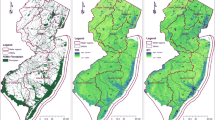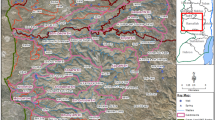Abstract
A hydrologically sensitive area (HSA) is an area with a very quick response to runoff and higher surface runoff probability since all watersheds are prone to generate runoff in one way or the other. The accurate description of runoff generation in time and space has important practical significance for land use and watershed management. The aim of this article was to establish HSAs identification method based on topographic index, and to estimate the spatio-temporal variability of surface runoff probability in different periods. The sensitive month was defined using critical monthly surface runoff probability combined with topographic index. Then the corresponding spatial and temporal boundary of HSA was estimated by the relation of average annual runoff and topographic index. The presented approach was applied in Meishan watershed, which is humid in the summer and has a monsoon climate. The analysis results indicated the probably sensitive months are from February to October with spatial topographic index distribution ranging from 13.02 to 17.13. April–October was estimated as seasonal HSAs with topographic index ranging from 9.21 to 14.05. In addition, the inter-annual variability of seasonal HSAs is much greater and the critical topographic index is 9.21 in July.








Similar content being viewed by others
References
Agnew LJ, Lyon S, Gérard-Marchant P et al (2006) Identifying hydrologically sensitive areas: bridging the gap between science and application. J Environ Manage 78:63–76
Beven KJ, Kirkby MJ (1979) A physically based, variable contributing area model of basin hydrology. Hydrol Sci J 24:43–69
Boughton WC (1990) Systematic procedure for evaluating partial areas of watershed runoff [J]. J Irrig Drain Eng 116(1):83–98
Brooks ES, Boll J, Mcdaniel PA (2007) Distributed and integrated response of a geographic information system-based hydrologic model in the eastern Palouse region, Idaho. Hydrol Process 21:110–122
Chuang YC, Liaw SC, Jan JF, Hwong JL (2008) Dynamic change of hydrologically sensitive areas in the Lien-Hwa-Chi watersheds. J Geogr Sci 51:21–46
Dean S, Freer J, Beve K et al (2009) Uncertainty assessment of a process-based integrated catchment model of phosphorus. Stoch Environ Res Risk Assess 23:991–1010
Dunne T, Black RD (1970) Partial area contributions to storm runoff in a small New England watershed. Water Resour Res 6(5):1296–1311
He L et al (2012) Application of loosely coupled watershed model and channel model in Yellow River, China. J Environ Inform 19(1):30–37
Kong FZ, Rui XF (2003) Calculation method for the topographic index in TOPMODEL. Adv Water Sci 14:41–45
Lyon SW, Walter MT, Gérard-Marchant P et al (2004) Using a topographic index to distribute variable source area runoff predicted with the SCS curve-number equation. Hydrol Process 18:2757–2771
Schneiderman EM, Steenhuis TS, Thongs DJ et al (2007) Incorporating variable source area hydrology into a curve-number-based watershed model. Hydrol Process 21:3420–3430
Walter MT, Walter MF, Brooks ES et al (2000) Hydrological sensitive areas: variable source area hydrology implications for water quality risk assessment. J Soil Water Conserv 55:277–284
Wolock DM, McCabe GJ (1995) Comparison of single and multiple flow direction algorithms for computing topographic parameters in TOPMODEL. Water Resour Res 31:1315–1324
Yong B, Zhang WC, Chen YH (2007) A new algorithm of the topographic index ln(α/tanβ) in TOPMODEL and its resultant analysis. Geogr Research 26:37–45
Zhang JN, Huang Y (2002) Studies on the water quality evaluation in the hydrological sensitive areas in America. Sci Tech Inform Soil Water Conserv 4:19–22
Zhang Y, Xia J, Shao QX (2013) Water quantity and quality simulation by improved SWAT in highly regulated Huai River Basin of China. Stoch Environ Res Risk Assess 27:11–27. doi:10.1007/s00477-011-0546-9
Acknowledgments
This study was supported by the National Scientific Foundation of China (NSFC) (No. 41371052,U1203282, No. 51269026) and sponsored by Qing Lan Project. The authors are very grateful to the editors and the anonymous reviewers for their insightful comments and suggestions.
Author information
Authors and Affiliations
Corresponding author
Rights and permissions
About this article
Cite this article
Xue, L., Bao, R., Meixner, T. et al. Influences of topographic index distribution on hydrologically sensitive areas in agricultural watershed. Stoch Environ Res Risk Assess 28, 2235–2242 (2014). https://doi.org/10.1007/s00477-014-0925-0
Published:
Issue Date:
DOI: https://doi.org/10.1007/s00477-014-0925-0




